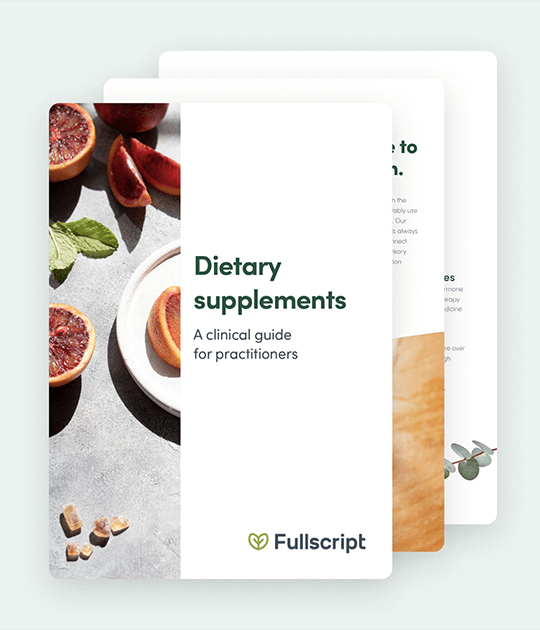
The gut microbiome, probiotics, and prebiotics
The gut microbiome is a complex system of microorganisms (fungi, bacteria, viruses, etc.) that live within the human gastrointestinal (GI) tract. (1) This track spans the mouth, stomach, small intestine, pancreas, liver, and large intestine. (2) Beneficial, or helpful, bacteria found naturally in the GI tract make up a majority of the probiotic supplements on the shelf. The goal is to increase levels of “good” bacteria while decreasing the bad. Another way to increase the levels of helpful bacteria is by consuming enough prebiotics. Prebiotics are fiber supplements that feed beneficial bacteria. (3)Gut microbiome functions
In a healthy individual, the gut microbiome is largely responsible for maintaining immune function and the digestive process. It’s also in constant communication with the brain and helps determine emotional response. (4)Immune system
The gut microbiome is sometimes referred to as the body’s largest immune organ. It forms a protective barrier that keeps toxins and harmful bacteria or viruses from entering the blood. (5) Additionally, the more beneficial bacteria that grow, the less room and resources are available for the harmful ones.Digestive system
The beneficial microorganisms consume fiber that the human body cannot adequately digest on its own. Through this process, the organisms create a byproduct called short chain fatty acids (SCFAs), which serve as a significant energy source for various cells in the body. (6)Emotion
The gut microbiome and the brain are in constant communication. Think of “gut feelings” or feeling your “stomach drop”- these sensations are due to the interaction between the brain and the gut. Scientists have labeled this phenomenon the gut-brain axis. Despite not understanding the precise mechanism that allows this communication, many scientists are reasonably confident that the gut microbiome influences pain, mood, and anxiety. (7)Main functions of kidneys
The kidneys are a pair of organs, each the size of a cell phone, located towards the back in the upper abdominal area. (8) Their primary function is trifold: They secrete important hormones, regulate blood pressure, and excrete toxins and excess minerals and vitamins.Secretory
Kidneys release essential hormones, like vitamin D and erythropoietin. The kidneys transform vitamin D into the usable hormone that keeps teeth and bones healthy. Erythropoietin, produced solely by the kidneys, stimulates red blood cell production. (9)Regulatory
Kidneys are responsible for regulating the amount of water, minerals, and vitamins in the body. Excess water, toxins, vitamins, and minerals are removed via urine production. This directly impacts bodily functions like blood pressure. (10)Excretory
Kidneys are responsible for removing byproducts that occur from normal bodily functions. For example, when the liver metabolizes proteins, it creates urea. (11) Uric acid and creatinine are other commonly removed byproducts. Kidneys also regulate the body’s levels of vitamins and minerals including potassium, sodium, and phosphate. (12) Minerals and vitamins can also cause substantial damage to the body if not properly removed. For instance, excessive amounts of phosphorus cause chemical changes that cause the body to pull calcium from the bones. (13) If a kidney is not functioning correctly, though, serious consequences follow. They release fewer hormones that the body relies on for healthy red blood cell production and make less usable vitamin D. They also won’t be able to regulate the blood or filter toxins from the body effectively. This can cause symptoms like itchy skin, trouble breathing, imbalanced gut microbiome, and, if left untreated, death. (14)How kidney problems cause an imbalanced gut microbiome
People with kidney problems often experience gut dysbiosis, which means that the makeup of their gut microbiome skews heavily towards the harmful bacteria. Beneficial bacteria die off due to a myriad of reasons; these include consequences of necessary diet changes, the inevitable build-up of uremic and nitrogenous toxins, and the medications and antibiotics many kidney patients take daily. These factors create a degenerative feedback loop that, eventually, causes more harm to the kidneys. (15)Diet
Toxins are no longer being filtered from the body, so people with kidney problems need to monitor their food for phosphorus, potassium, protein, and sodium. Overtime, these substances will build up in the bloodstream and damage other organs. For example, excess phosphorus will cause chemical changes in the body that result in calcium being pulled from bones, making them weaker. (16) In many cases, this means cutting down prebiotic foods, like fruits and vegetables, due to their high levels of phosphorus or potassium. Click here for a comprehensive list of foods for kidney health. (17)Uremic and nitrogenous toxins
As a result of a failing kidney, uremic and nitrogenous toxins accumulate in the blood and eventually travel into the GI tract, past the protective barrier. Once inside, these toxins make it easier for some harmful bacteria to thrive and harder for the beneficial ones. Some harmful bacteria even produce uremic toxins of their own, adding to overall levels of toxins. (18)Medications and antibiotics
People with kidney problems take a wide array of medications to manage their condition, including phosphate binders and high blood pressure medications. Due to various reasons, including those discussed here, these patients often have less effective immune systems and will need antibiotics frequently. Antibiotics don’t just kill off the harmful bacteria, though. They also kill the beneficial ones.
Probiotics and kidney function
Certain probiotic strains, S.thermophilus (KB19), L.acidophilus (KB27), and B.longum (KB31), can capitalize on the toxins that accumulate in the large intestine (colon) via a large blood vessel nearby (20). With the help of two probiotics fibers, the beneficial bacteria can metabolize (consume) the toxins and use them as a food source. (21) These toxins are later excreted from the body during bowel movements, helping take some burden off the kidneys. (22) Taking a general probiotic, with strains for gut health, may also help people with kidney problems. While they won’t actively consume toxins, they can help repair the gut microbiome and alleviate gut dysbiosis. In turn, patients may see decreased inflammation and fewer uremic producing bacteria. (23)The bottom line
Many kidney patients could benefit from prebiotics and probiotics, but should choose these supplements carefully. Patients should only take prebiotic and probiotic formulations that have been approved by their healthcare provider to ensure they aren’t accidentally breaking their dietary restrictions.Disclosure: This article was written in partnership with Kibow Biotech. All supplier partnerships have been approved by doctors on Fullscript’s Medical Advisory Team, and this content adheres to all guidelines outlined in our content philosophy. Fullscript has not been compensated financially for the publication of this article.
- Al Khodor, S., Shatat, I.F. Gut microbiome and kidney disease: a bidirectional relationship. Pediatr Nephrol 32, 921–931 (2017). https://doi.org/10.1007/s00467-016-3392-7
- Your Digestive System & How it Works. (2017, December 1). Retrieved from https://www.niddk.nih.gov/health-information/digestive-diseases/digestive-system-how-it-works
- Robinson, K. (2019, September 26). Prebiotics: Health Benefits and Sources. Retrieved from https://fullscript.com/blog/prebiotics
- Deepika Bagga, Johanna Louise Reichert, Karl Koschutnig, Christoph Stefan Aigner, Peter Holzer, Kaisa Koskinen, Christine Moissl-Eichinger & Veronika Schöpf (2018) Probiotics drive gut microbiome triggering emotional brain signatures, Gut Microbes, 9:6, 486-496, https://doi.org/10.1080/19490976.2018.1460015
- Yang, T., Richards, E.M., Pepine, C.J. et al. The gut microbiota and the brain–gut–kidney axis in hypertension and chronic kidney disease. Nat Rev Nephrol 14, 442–456 (2018). https://doi.org/10.1038/s41581-018-0018-2
- Douglas J. Morrison & Tom Preston (2016) Formation of short chain fatty acids by the gut microbiota and their impact on human metabolism, Gut Microbes, 7:3, 189-200, https://www.tandfonline.com/doi/full/10.1080/19490976.2015.1134082
- Deepika Bagga, Johanna Louise Reichert, Karl Koschutnig, Christoph Stefan Aigner, Peter Holzer, Kaisa Koskinen, Christine Moissl-Eichinger & Veronika Schöpf (2018) Probiotics drive gut microbiome triggering emotional brain signatures, Gut Microbes, 9:6, 486-496, https://www.tandfonline.com/doi/full/10.1080/19490976.2018.1460015
- Biga, L. M., Dawson, S., Harwell, A., Hawkins, R., Kaufmann, J., LeMaster, M., … Runyeon, J. (n.d.). 25.1 Internal and External Anatomy of the Kidney. In Anatomy & Physiology. OpenStax/Oregon State University. https://open.oregonstate.education/aandp/chapter/25-1-internal-and-external-anatomy-of-the-kidney/
- Sahay, M., Kalra, S., & Bandgar, T. (2012). Renal endocrinology: The new frontier. Indian journal of endocrinology and metabolism, 16(2), 154–155. https://doi.org/10.4103/2230-8210.93729
- Fullscript Medical Advisory Team. Blood Pressure Support Protocol. (2020, February 28). Retrieved from https://fullscript.com/blog/blood-pressure-support-protocol
- National Center for Biotechnology Information. PubChem Database. Urea, CID=1176, https://pubchem.ncbi.nlm.nih.gov/compound/Urea (accessed on Mar. 16, 2020)
- Your Kidneys & How They Work. (2018, June 1). Retrieved from https://www.niddk.nih.gov/health-information/kidney-disease/kidneys-how-they-work
- Phosphorus and Your CKD Diet. (2019, August 30). Retrieved from https://www.kidney.org/atoz/content/phosphorus
- What Is Chronic Kidney Disease? (2017, June 1). Retrieved from https://www.niddk.nih.gov/health-information/kidney-disease/chronic-kidney-disease-ckd/what-is-chronic-kidney-disease
- Jazani, N. H., Savoj, J., Lustgarten, M., Lau, W. L., & Vaziri, N. D. (2019). Impact of Gut Dysbiosis on Neurohormonal Pathways in Chronic Kidney Disease. Diseases (Basel, Switzerland), 7(1), 21. https://doi.org/10.3390/diseases7010021
- Mineral & Bone Disorder in Chronic Kidney Disease. (2015, November 1). Retrieved from https://www.niddk.nih.gov/health-information/kidney-disease/mineral-bone-disorder
- Top Foods for Optimal Kidney Health. (2019, December 5). Retrieved from https://fullscript.com/blog/kidney-health-foods
- Velasquez, M. T., Centron, P., Barrows, I., Dwivedi, R., & Raj, D. S. (2018). Gut Microbiota and Cardiovascular Uremic Toxicities. Toxins, 10(7), 287. https://doi.org/10.3390/toxins10070287
- Ranganathan, N., Vyas, U. (2017, April, 23). Possible Pathways of Gut Microbiome Modulationby Probiotics in Chronic Kidney Disease. ISN WCN, Mexico. https://kibowbiotech.com/pdfs/WCN2017_0450.pdf
- Ranganathan N (2015) Concept and Potential of Enteric Dialysis® – Treating the Cause of Dysbiosis and not the Symptoms in Chronic Kidney Diseases (CKD). J Nephrol Ther 5: 209. doi:10.4172/2161-0959.1000209
- Ranganathan N (2018) Reality of “Enteric Dialysis ®” with Probiotics and Prebiotics to Delay the Need of Conventional Dialysis . J Nephrol Ther 8: 319. doi:10.4172/2161-0959.1000319
- Ranganathan, N., Ranganathan1, P., D’Silva, H., Vyas, U., Pechenyak2, B., & Weinberg, A. (2017). Quality of Life in Chronic Kidney Disease Patients Using a Synbiotic Dietary Supplement: a Survey. International Journal of Research Studies in Medical and Health Sciences, 2(1), 11–24. doi: 10.22259/ijrsmhs.0201004
- (2017). Chronic Kidney Disease: The Gut-Kidney Connection?. Integrative medicine (Encinitas, Calif.), 16(2), 14–16.https://www.ncbi.nlm.nih.gov/pmc/articles/PMC6413637/

